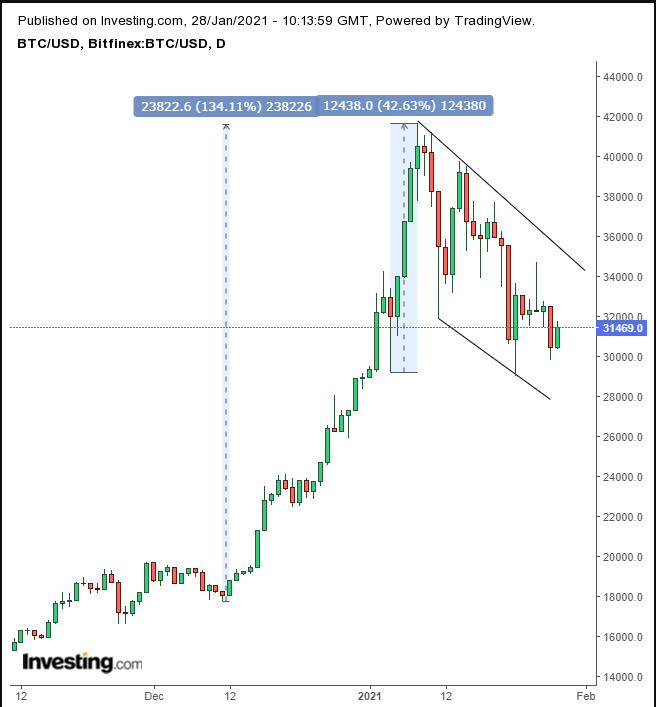Bitcoin has rebounded from yesterday’s selloff, and, at time of writing is trading around the $31,200 level. Still, the digital currency is down 27% from its Jan. 8, all-time high above $41K. So is this a buying dip?
Not according Scott Minerd, Chief Investment Officer at Guggenheim. The investment bank's CIO notes that, “Right now, the reality of the institutional demand that would support a $35,000 price or even a $30,000 price is just not there.”
Minerd may be correct that smart money investors aren't crypto fans, but he's likely not taking into account newly emerging 'young money,' youthful investors that CNBC's Jim Cramer believes have been changing the character of the market overall and driving the digital currency asset class higher.
Some would point to the current, Reddit-fueled GameStop (NYSE:GME) mania as proof that young investors, in collaboration with retail investor friends and family are indeed changing the way things are done on Wall Street. But investors tied to social media directives may not yet have the upper hand, particularly if institutional money—with its deeper pockets and broader clout—figures out how to navigate the current situation. Or the stonks frenzy ends with a crash and, in all likelihood, some retail traders are left holding the significantly deflated bag.
As well, our reading of the Bitcoin chart is pointing higher, Minerd's assessment notwithstanding. Technicals are signaling the digital token is heading toward the $50,000 mark. Whether because zero interest rates and massive stimulus will weaken the dollar, or because a stock market crash could well benefit Bitcoin as a safe haven, or because young traders will keep bidding it up, or just because, this could turn out to actually be a buying dip.

The current decline is congested. That happens when there is an area crowded with both buy and sell trade orders. The fact that tilt is downward is a mark of profit-taking following a spike, which certainly occurred.
This is actually healthy for the asset. All the dead weight is cut off and the leaner remainder is ready for another jump.
In other words, the odds of a decline are reduced, since whoever wanted out is already gone. That means that whoever gets in now will stay, helping push and pull the crypto into its next leg up.
This dynamics sets up a chain reaction, creating its own momentum, pushing prices higher. The expectation in such a setup is that the price will at least repeat its prior move.
While we could have measured the move from the Dec. 11 lows of $16,528, providing a $23,000 move prediction from the breakout point, we’re operating here on the most conservative, sharpest move that went straight up without pause, from the Jan. 4 low of $29,178.
That provides an expected $12,438 move from the point of breakout.
Caution, however, is warranted. The pattern is complete only after a decisive upside breakout, itself open to interpretation. The more conservative a trader, the greater the penetration and confirmation they'll seek.
Trading Strategies
Conservative traders should wait for an upside breakout that will overtake the all-time high, then wait for a pullback to retest the pattern’s integrity, before going long.
Moderate traders would go long after an upside breakout with at least one, clear, long green candle followed by a return move, for a better entry, if not for added confirmation.
Aggressive traders could enter a contrarian, long position now, but only if they understand and accept the risk of acting prematurely to beat the crowd and have a tight trade plan they're committed to.
Here’s an example of a coherent plan:
Trade Sample
- Entry: $30,000
- Stop-Loss: $29,000
- Risk: $1,000
- Target: $40,000
- Reward: $10,000
- Risk:Reward Ratio: 1:10
Author's Note: This is just a trade sample. It doesn’t necessarily represent the market, for which the analysis is in the body of the post. Either the sample or the analysis—or both—could be wrong. We don’t know what will happen next but are merely discussing possibilities based on what generally happens when such dynamics occur. Your budget, timing and temperament will impact your trade. Learn how to form a plan suited for your needs. Until then keep your trades small.
